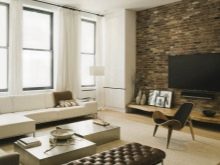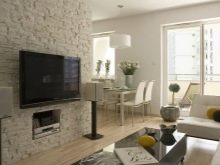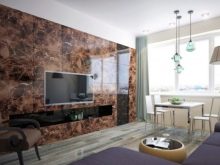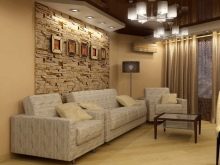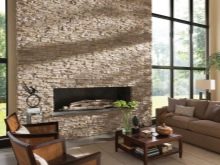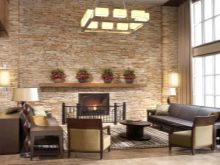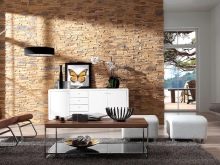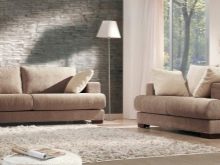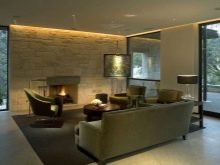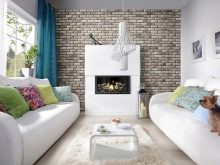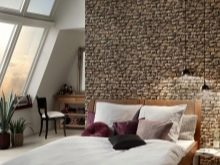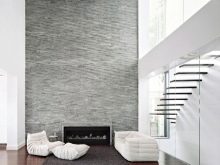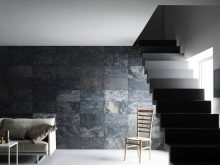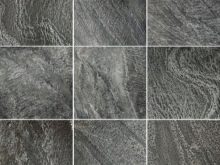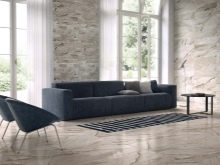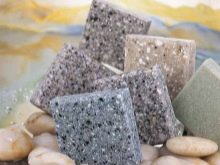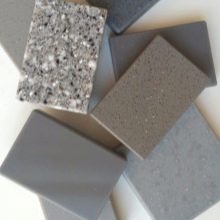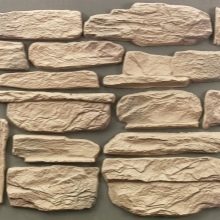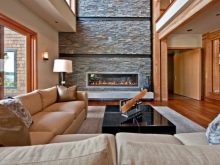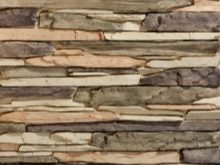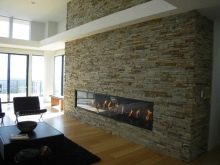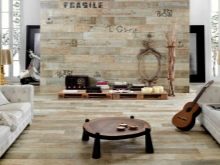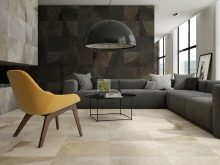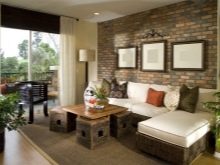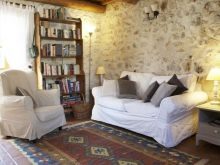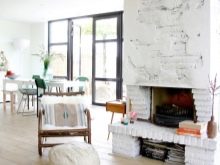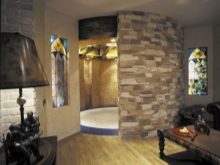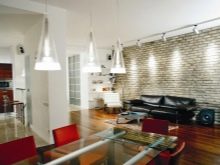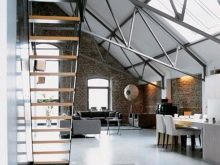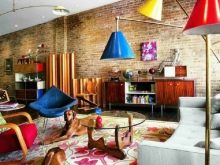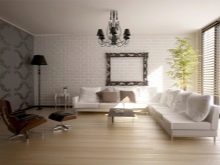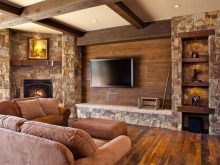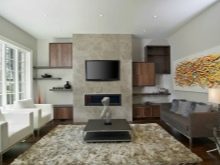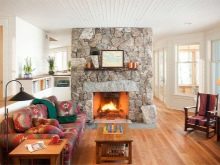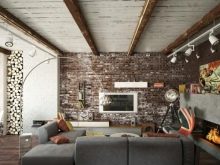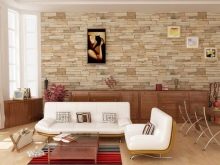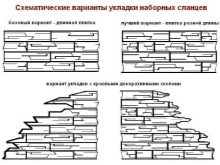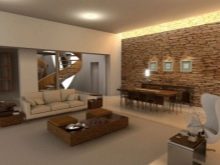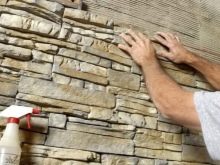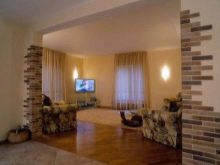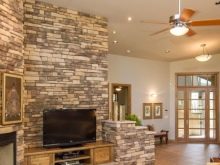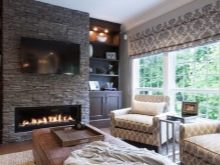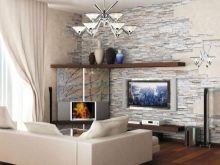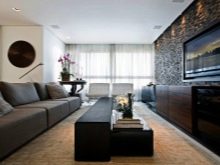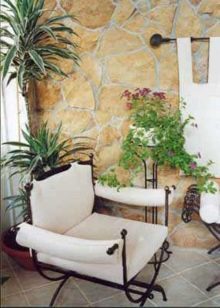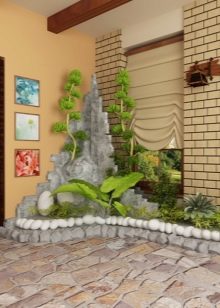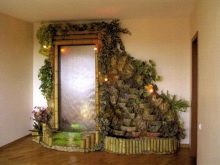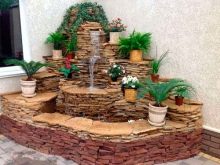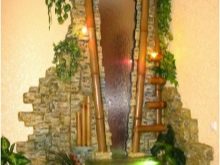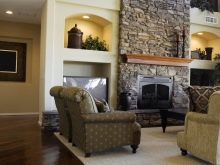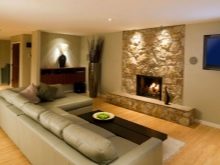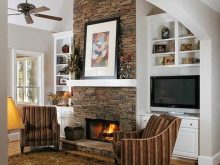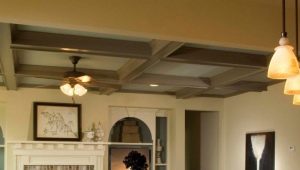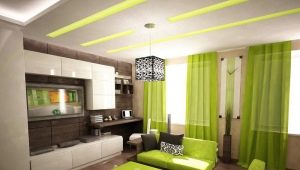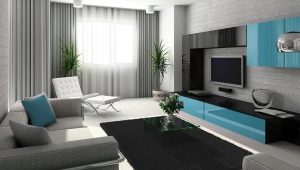Decorating the walls in the living room decorative stone
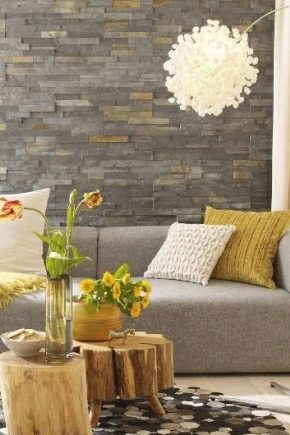
Decorative stone is well known in the market of building and finishing materials and is in high demand. Being harmoniously combined with other elements of decorative design, it is often the center of the composition, and gives the room a stylish and aesthetic look.
Advantages and disadvantages
Finishing stone is one of the most beautiful and modern materials, it is in demand, we buy and has the following undeniable merits:
- the fragments have a small weight, which makes it possible to decorate large areas of the surface, without fear of the collapse of the supporting structures and the additional load on the foundation elements;
- material has high strength and long service life;
- the way of finishing with a decorative stone allows to hide the defects of the walls and distracts from unsuccessful planning;
- due to the wide range of prices, there is the possibility of acquiring material at an affordable price, which makes it even more popular and in demand;
- the stone is easy to clean and resistant to mechanical stress. This allows it to be used for finishing fireplaces, arches and corners;
- the maintainability of the material lies in the fragmentary repair of the damaged element, without the need for a complete replacement of the coating;
- the incombustibility of the material and its resistance to rapid temperature changes allows you to lay them wood fireplaces and near fireplace space;
- the possibility of self-laying due to the flat surface of the back side of the elements. Due to this, the material is glued to the surface of the base, like a regular tile. The artificial stone is about 2 centimeters thick and does not take space.
The disadvantages of a decorative stone include the cold, hard-to-work surface of natural specimens and the fragility of certain types of artificial models.
Types and properties of the material
The use of natural stone is complicated by high weight, cold nature, energy-intensive processing and high cost.Therefore, when decorating living rooms, artificial decorative materials are used, which in their appearance are no different from natural counterparts.
The production technology consists in pouring the solution into the forms with further drying and firing of the blanks. Then the elements are either coated with a special impregnation, or icing is applied on them.
Decorative products can have a concrete, plaster, acrylic, polyester and ceramic base.
The form of release can serve as a stone veneer in roll or sheet design:
- Stoneware stones are made of feldspar, mineral additives and clay. They are pressed under high pressure and produced in matte, glossy and embossed versions.
- Polyester agglomerates are made with the addition of marble chips, limestone and granite. This material perfectly imitates natural stones and, due to its high strength and fire resistance, can be used for lining fireplaces.
- Colored concrete stones consist of sand, cement, expanded clay, pumice and dyes.This type has a large range of products with a huge variety of shades and textures.
- The stone from plaster is considered the most budgetary option, has the small weight and is easily mounted on plasterboard surfaces. The disadvantages include excessive brittleness of the material and the need to cover the lined wall with water-repellent compositions.
- Acrylic products have a beautiful smooth surface, but their use in fireplace zones should be limited. This is due to the risk of release of harmful substances when the material is heated.
- Products made of expanded clay sand and perlite have high strength, but they are much more expensive than other types.
The clinker tile is also a type of decorative stone and is a panel with imitation brickwork. The material is produced in a wide variety of shades, characterized by high strength and ideally smooth surface. It weighs much less than a decorative brick, and the thickness varies from 1 to 3 cm. The models are heat-resistant and can be used to design fireplace zones.
The color of the future product is formed during its production: dyes and pigments are added to the raw materials. Some types of stone can be painted or glazed after manufacture. If during the installation process it turns out that the individual stones differ in color, then the finished surface is treated with a special compound that levels the difference.
Finishing options
A wide range of decorative stone provides ample opportunities to create a variety of styles:
- For a gentle Provence, a snow-white glossy surface will be a good solution, and for modern hi-tech and minimalism a black-and-white contrast will suit.
- In ethnic African styles, relief stones of various sizes of red and yellow-brown tones will look good.
- When designing Scandinavian and rustic trends, you can use light wood shades in combination with a matte surface. In order to achieve the effect of antiquity, you need to use a coarse stone or patinated model.
- The classic living room is decorated with dark brown stones.
- The combination of aged stone with Venetian plaster will harmoniously look in retro style.
- For a spacious rococo and baroque living room, it is recommended to form semi-columns and lay them out with stones of dark shades.
- In techno-interiors, the masonry must be illuminated with the help of small metal lamps of simple forms.
- And in the forefront of a good neighborhood will be openwork forging and dark stone.
When making a room of a small size, you should use the fragmented decoration technique. Walls fully lined with stone will create a depressing atmosphere and make the space heavy and cluttered. In the premises of this type is the corner decoration, as well as the design of the fireplace, arched, door zone. It is possible to decorate a small section of the central wall.
Decorative masonry can perfectly cope with the zoning of the living room, visually separating the rest area from the meeting area.
If the living room area allows, the creation of a living corner where artificial mini-reservoirs, cascading waterfalls and fountains decorated with decorative stone will be located will be an interesting technique. Aquariums and large tropical plants look beautiful against the masonry.Successful is the combination of stone and wood. It harmonizes well with greenery and emphasizes natural unity. Stone can be finished not only with walls and fireplaces: the design of shelves and bar counters looks stylish and interesting.
When decorating living rooms with masonry, you must consider the size and degree of illumination of the apartment. Dark and too relief stone is suitable only for spacious halls. In small rooms should be used smooth and light copies, combining fragmented masonry with wallpaper. A popular technique is the decoration of a niche under a TV decorative stone.
This design option is suitable for small spaces. It allows with the help of architectural solutions and stone panels to issue a full-fledged recreation area. It should be borne in mind that the stone is a rather coarse finishing material, therefore it is necessary to add some comfort to the interior. This can be done with upholstery, carpets, pillows and textiles.
To warm the stone finish will help the wooden floor with a clear pattern of wood fibers and a carved mantelpiece in combination with a forged grille. An important role is played by the living room lighting.
With a lack of natural light, you need to equip the room with additional lighting fixtures, otherwise the masonry of dark colors will look too gloomy.
Useful tips
Before you start decorating the walls of the living room, you should determine what area will be occupied by stone. To do this, draw a diagram with a detailed arrangement of fragments, and then mark the boundary of the masonry on the wall. Having calculated the amount of material needed for installation, add 10% to the value obtained. This will help cover losses during fitting and cutting, as well as in case of accidental damage to the material. Then you need to expand the stone on the floor, in accordance with the drawn scheme, and pick up the elements in shape and size, taking into account the seams.
Next, you should clean the wall from the old finish, align and prime. Start facing facing from the corner upwards. Laying is done in rows, in which the connecting seams between adjacent stones of one row are located in the center of the stones of the second row. Shale and sandstone materials are mounted using seamless technology.
For finishing, you should use a special glue, which is selected for each composition individually.
After a few days you need to spend antifungal surface treatment, which is performed with water-based varnish. This should be done in the event that the procedure was not carried out at the time of manufacture. This will give the surface a shine and prevent rapid contamination.
Beautiful examples of decorative masonry
Sophisticated design and proper use of artificial and natural stone will create in the living room a unique atmosphere of pomp and style.
A successful combination of corner trim and picture framing will make the living room elegant and modern.
Making a television area with masonry is a good example of space zoning.
The green corner in the living room is the harmony of plants and stone.
The cascade waterfall will become the central composition of the interior and significantly enliven the space.
Refractory masonry is the ideal solution for finishing the fireplace area.
On how to properly lay a decorative stone, you will learn from the following video.
